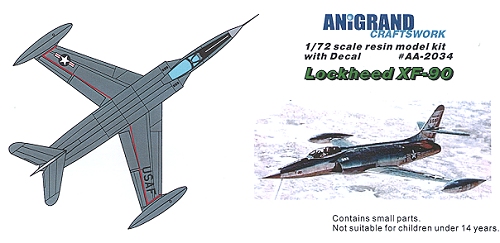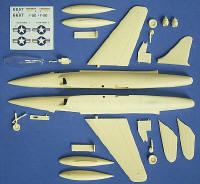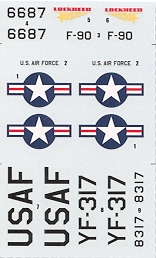
| KIT: | Anigrand 1/72 Lockheed XF-90 |
| KIT #: | AA-2034 |
| PRICE: | $49.00 from Nostalgic Plastic |
| DECALS: | Two options |
| REVIEWER: | Scott Van Aken |
| NOTES: | Short run resin kit with vacuformed canopy |

| HISTORY |
One of the few Kelly Johnson designs not to see full production was the XF-90. Based on the then-latest German research and an ill-defined USAF requirement for a long range penetration fighter, the XP-90 was contracted in June 1946 for two prototype aircraft. Originally designed as a delta wing, wind tunnel testing showed major flaws and a redesign was done. What came out of that was a rather large aircraft powered by two J-34 engines and armed with 6 20mm cannon. Due to the poor fuel consumption of early turbojets, large tip tanks and supplemental under wing tanks were needed to meet the range requirements.
In order to meet the high stresses required for ground attack missions, a stronger aluminum alloy was used which made the XF-90 50% heavier than the rival McDonnell XF-88. The end result was that the power to weight ratio was unsatisfactory and doomed the aircraft to failure. Testing showed a top speed in level flight of only 668 mph which made it slower than the F-86A that was already in USAF service. As there was no more powerful engine available, the result was that the XF-90 lost out to the XF-88 in the competition. Of the two prototypes built, one was expended in nuclear bomb tests in 1952 while the other was destroyed in structural testing at NACA's Cleveland laboratory.
Late note. Much to my surprise, it seems that the one used in bomb testing has been decontaminated, recovered, and is now sitting in a bit of a twisted heap awaiting some major restoration. The fuselage is remarkably intact, showing how strong the airframe actually was.
| THE KIT |
 Despite
the fact that the XF-90 was a failure as an aircraft, to me, it has to be
one of the top 10 coolest looking aircraft ever built. It was so cool that
it was used as a mainstay of the Blackhawk's comic book for years.
Despite
the fact that the XF-90 was a failure as an aircraft, to me, it has to be
one of the top 10 coolest looking aircraft ever built. It was so cool that
it was used as a mainstay of the Blackhawk's comic book for years.
Molded in Anigrands usual tan resin, this kit is quite typical of what this Hong Kong company has produced over the last few years. This really is a small scale operation with the company employing about 10 people with the production of these kits. That means each is literally hand cast. The result is a generally good kit with some molding flaws that are going to happen when you have this kind of production. The image to the left is of a cleaned up and perfect kit from Anigrand to show what you get in the kit. I was having some problems downloading images from my camera so cannot show my review sample at this time. However, it looks very much like what you see.
 Generally, the flaws are in
the form of air bubbles and this kit has a few of them in the edges of a
few parts. In this kit they are found in the exhaust and the tail planes.
However, I have to say that this example is cleaner than some of my more
recent builds in this respect. The interior consists of a seat and control
stick that are glued into the pre-formed cockpit tub that is in the
fuselage halves. Intakes are blanked off with resin parts. Wings and tail
planes are single castings with large alignment pins for the wings, a nice
touch and something that is a recent addition to Anigrand kits. Though the
entire tail section of the real plane was able to move, the kit provides
just the neutral position.
Generally, the flaws are in
the form of air bubbles and this kit has a few of them in the edges of a
few parts. In this kit they are found in the exhaust and the tail planes.
However, I have to say that this example is cleaner than some of my more
recent builds in this respect. The interior consists of a seat and control
stick that are glued into the pre-formed cockpit tub that is in the
fuselage halves. Intakes are blanked off with resin parts. Wings and tail
planes are single castings with large alignment pins for the wings, a nice
touch and something that is a recent addition to Anigrand kits. Though the
entire tail section of the real plane was able to move, the kit provides
just the neutral position.
In terms of options, you have two. One is to build it with the wheels up and the other is to add on the tip tanks. This second option is done by cutting off the wing tips and adding the tanks. I'd have liked to have seen the tanks molded such that they were slipped onto the end of the existing wings as it would have made alignment and clean-up a bit easier. The builder will have to add the nose pitot and the gear retraction struts. As usual only one canopy is provided and while this one is clearer than previous examples, the framework is still not very well defined, making masking more difficult.
Instructions are standard Anigrand with a history and exploded diagram of the kit parts on one side and a three-view for painting and decaling on the other. This is more than adequate for a kit of this type. Interior and wheel well color info is given on the painting guide. The small decal sheet provides markings for the first prototype and a totally spurious '8317'. The decals are well printed and a bit thick though they will work quite well. Those of you with the Wings vacuform kit may want to use that kit's thinner decals.
| CONCLUSIONS |
Once more, Anigrand provides the sorts of subjects that modelers like to see. This XF-90 is a very cool looking aircraft and should be a relatively straight-forward build. Those with some experience building resin kits will find this one to be no problem. If you are considering getting into resin aircraft kits, then this would be a nice one with which to start building a collection.
| REFERENCES |
Lockheed Aircraft since 1913, by Rene J Francillon, 1987, Naval Institute Press
Thanks to Nostalgic Plastic for the review kit.
If you would like your product reviewed fairly and quickly by a site that has around 300,000 visitors a month, please contact me or see other details in the Note to Contributors.